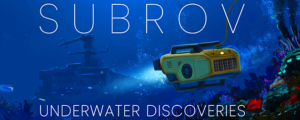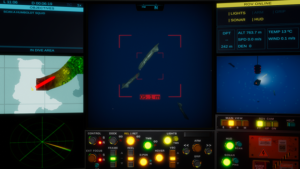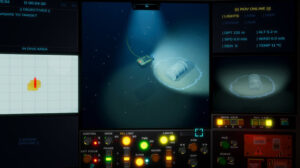Ocean Exploration Through Video Game Simulation: “subROV”

A new simulation video game developed in collaboration with BIOS researchers is set to debut on the gaming platform Steam in late November 2022. Created by sound designer José González, subROV: Underwater Discoveries puts players behind the controls of a deep-ocean remotely operated vehicle (ROV). Drawing inspiration from his love of ocean exploration, as well as real-world scientific investigations and ROV expeditions, González produced a series of simulated dives for players to pilot their ROV through.
Beginning this fall, ocean exploration enthusiasts will have a new window into the deep sea and its inhabitants through the virtual world of subROV: Underwater Discoveries, a PC-based simulation video game. Developed with input from researchers at BIOS and the Schmidt Ocean Institute (SOI) in Palo Alto, California (U.S.), subROV allows players to assume the controls of a remotely operated vehicle (ROV) and pilot it on a variety of scientific missions.
The game is the brainchild of José González, a freelance composer and sound designer with over two decades of experience in the video game industry. His interest in the deep ocean started when he came across livestreams of ROV expeditions conducted by the U.S. National Oceanic and Atmospheric Administration and SOI as part of their deep-sea mapping and research programs. Countless hours of footage recorded at depth yielded glimpses of bioluminescent fishes, fragile cold-water corals, hydrothermal vents, and vast seamounts.
“I was immediately captivated by the display of advanced robotics technology and the overall sense of other-worldliness,” González said.

One of the simulated dives was developed and funded by a U.S. National Science Foundation (NSF) research project led by BIOS comparative physiological and zooplankton ecologist Amy Maas. The investigation focuses on the impacts of low oxygen zones in the deep ocean and how the changes in oxygen impact the swimming and respiration rates of animals in that ecosystem. González designed a dive that integrated the top two concepts in Maas’ NSF project that she wanted players to walk away with (except using “deep ocean angry red squid,” as she referred to them, because gamers want to have fun).
To his surprise, when he looked for software to recreate the experience of piloting an ROV, there were few options other than expensive commercial simulators. Seeing a niche in the market, and wanting to build a prototype that would allow him to practice advanced sound design, González decided to use ROV exploration as an overall theme for the game.
The premise of subROV is that players have command of a research vessel and its deep-ocean ROV, affectionately named Suberto. With control of the research vessel, players choose from a variety of dives, each with their own scientific objectives – from charting the seafloor to retrieving sediment cores, from gathering oceanographic data to observing the behavior of deep-sea squid. By piloting the ROV, rendezvousing with ocean buoys and downloading data, tracking discoveries, and successfully completing objectives, players can gain experience and climb the ranks from Trainee to Dive Master.
A BIOS Beta-tester
During the development of subROV, González reached out to ocean scientists for input, wanting to ensure the accuracy of both the mission designs and accompanying visuals. In what he described as a “series of Twitter jumps,” González connected with BIOS zooplankton ecologist Leocadio Blanco-Bercial in early 2021 and the two began collaborating over Skype meetings.
Blanco-Bercial began providing images, helping with scientific terminology, and supplying seafloor maps and ocean depth measurements to build out the backgrounds for each level.
“My role included helping to address questions related to the ocean, putting José in contact with the right people if those questions fell outside my field, and—very importantly—playing the game,” he said. “I played many of the first versions to see how well they reflected the reality of being underwater and on the deck of a research vessel, finding bugs in the game, and testing the playability of the game, or how easy, intuitive, and fun it is.”
The “fun” part was something that both Blanco-Bercial and González agreed was a key feature. However, Blanco-Bercial also realized that, if it was really fun to play, subROV could be an effective platform through which to share the work of BIOS scientists, weaving their research into the predefined dives that players choose from.
“I saw this as a great opportunity for BIOS science to reach a new, rapidly growing audience represented by the gaming community,” he said.
Submarines and Angry, Red Squid
In August 2021, BIOS comparative physiologist and zooplankton ecologist Amy Maas submitted a research proposal to the U.S. National Science Foundation (NSF) seeking to understand the impacts of climate change on marine organisms known as “diel vertical migrators.” These organisms, which include many species of fish and zooplankton, engage in massive migrations between cold, hypoxic deep waters during the day and warm, oxygenated surface waters at night, typically as a strategy to avoid predation while searching for food.
“Part of the NSF proposal included classroom and web-based activities designed to improve ocean literacy and technological fluency among the public,” Maas said. “I had been watching Leo beta test the video game and thought it could be a great resource for reaching different audiences than those we usually engage with.”
Maas reached out to González to ask if she could include him in the grant proposal with funding to develop a dive specifically related to the project.
“My thought was that if we could get gamers, whose goal is to have fun and not necessarily to be educated, to walk away from a dive knowing two things, then that is a major win,” Maas said. “First, that there are places in the ocean where there is low oxygen at depth; and second, that the low oxygen changes the swimming and respiration rates of animals in this ecosystem.”
After the grant was awarded in January 2022, Maas suggested highlighting one of the more charismatic diel vertical migrators: the Humboldt squid. Also known as jumbo squid, these carnivorous invertebrates can grow over 33 feet (10 meters) in length and weigh up to 100 pounds (50 kilograms). With Maas’ input, González developed a unique subROV dive that features Humboldt squid, schools of midwater fish, and readings of seawater oxygen data. The pair are also working to include information within the game on how low oxygen levels impact marine organisms.
For Maas, herself an avid gamer, the collaboration sells itself: “Who doesn’t like submarines and deep ocean angry red squid?”

Other dives in subROV recreate missions conducted by an ROV owned by the Schmidt Ocean Institute in California for deep-ocean exploration and environmental assessment and sampling purposes. González hopes the platform will continue to be used by scientists and institutions to share their research, offering players an opportunity to “experience first-hand the mysteries and thrills of ocean exploration.”
Full Steam Ahead
González, through his company sqr3lab, released the demo version of subROV on Steam, an online PC gaming distribution platform, on June 8, 2022—fittingly, also World Oceans Day. Steam allows González to gather technical feedback from demo players and provide updates on game development.
In addition to content developed with support from BIOS scientists, several of the subROV dives recreate missions conducted by SOI’s ROV SuBastian. These include the 2021 assessment of a deep-sea dump site off the coast of Southern California containing barrels of toxic waste from the production of the insecticide DDT, and the 2021 exploration of an unnamed seamount in the Phoenix Islands Archipelago, located in the Pacific Ocean about halfway between Hawaii and Fiji.
González plans to release subROV on Steam at the end of November and has thought about his goals for what started as a side project, but has now grown into something much bigger.
“I hope that oceanographic institutions and scientists will use it as a platform to showcase aspects of their research, and that people will use it to experience first-hand the mysteries and thrills of ocean exploration, which is what I myself want to do,” he said.
Counting down the days, Blanco-Bercial said: “I already have it in my Steam wishlist!”
